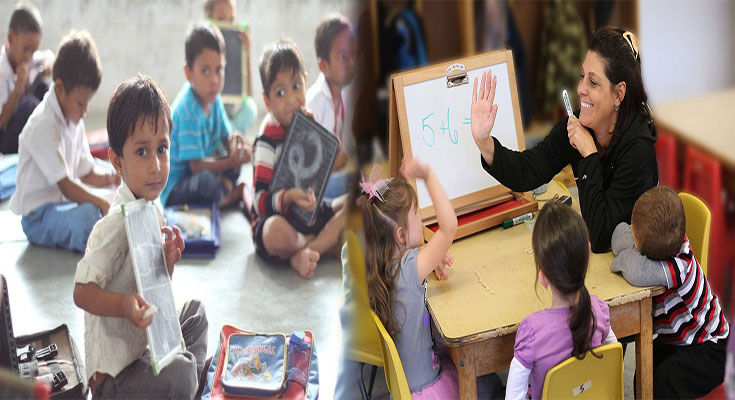Inclusive education is an educational approach that allows children with disabilities to participate in the classroom, get help if they need it, and receive the same quality of education as other students.
Inclusive education means providing access to education for all children, including those with special needs.
Inclusive education is about inclusion. It means providing access to education for all children, including those with special needs.
Inclusive education focuses on the individual child and their strengths, rather than on any deficits they may have due to their disability or difference. Inclusive classrooms are welcoming places where children learn from one another as peers rather than being segregated into separate groups based on ability level or disability status. In an inclusive classroom, all students can participate fully in the learning process and benefit from each other’s contributions; this approach helps develop positive attitudes about diversity among all members of society
Inclusive education recognizes that every child has the right to be educated in a school setting where they feel accepted and valued.
Inclusive education is a way to ensure that every child feels accepted and valued in their classroom. It’s also important for children to be included as part of the learning process, not singled out because they may have a disability or other needs that require special attention. Inclusive education promotes inclusion by providing teachers with training on how best to work with students who have disabilities, as well as tools such as modified curriculum materials (for example, books with large print).
Inclusive education aims to provide learning opportunities for students with disabilities so that they can reach their full potential.
Inclusive education is a philosophy that aims to provide learning opportunities for students with disabilities so that they can reach their full potential. Inclusive education means making sure everyone is included, providing equal opportunity for everyone, and making sure everyone has access to the same opportunities.
Inclusive education offers many benefits for both students with disabilities and those without them: it allows all students to learn from one another; it challenges stereotypes about people with certain abilities or conditions; by teaching together, both groups will gain understanding about each other’s needs and perspectives; this helps build empathy between different groups within society (for example, between disabled people who need support services and non-disabled individuals).
A key component of inclusive education is providing meaningful educational experiences for all students.
Inclusive education is not just about inclusion. It’s about providing meaningful educational experiences for all students. Inclusive classrooms are designed so that all students have access to the same curriculum, resources and experiences as their peers with disabilities – no matter what ability level or learning style they may have.
This means that if your child is in a special education class or has a 504 plan (which allows him/her to receive accommodations), then he/she will participate alongside his/her general education peers during classroom discussions and projects related to those topics. For example: if your child needs extra time on tests due to dyslexia or ADHD symptoms, he/she will still be able to take those tests alongside other kids his age; he’ll just get extra time per question instead of taking them separately like some general ed kids might do because they don’t need accommodations.
All students should receive an appropriate amount of support to maximize their potential.
Inclusive education is a philosophy that aims to provide all students with an appropriate amount of support to maximize their potential. This can mean different things for different students, depending on what they need. For example, if you have dyslexia and are struggling with reading or writing, you might benefit from having an extra tutor who specializes in helping people with learning disabilities. If your class is working on writing a persuasive essay about climate change and you’re struggling because English isn’t your first language, maybe it would be helpful for someone else in the class to help translate for you (or even just sit next to you).
Inclusive education means providing these kinds of supports without stigmatizing any individual or group; everyone should feel welcome at school regardless of race or ethnicity, gender identity/expression/sexuality/etc., income level/class standing, religious beliefs…the list goes on!
Research shows that children with disabilities who are included in regular-education classrooms perform as well as or better than their peers on standardized tests and other measures.
Research shows that children with disabilities who are included in regular-education classrooms perform as well as or better than their peers on standardized tests and other measures.
Including students with disabilities in general education classrooms is not only beneficial for them, but also for the broader school community. Students without disabilities benefit from being exposed to a wide variety of individuals and ideas, which helps them develop empathy and understanding for others. Teachers can use one-on-one time with students who need extra support to build relationships, which increases teacher satisfaction and retention rates at schools that have inclusive environments (Muller & Rief, 2006).
Inclusive education helps ensure that children with special needs have support services available to them, but it also ensures that all students are exposed to a wide range of experiences and challenges.
Inclusive education is a process, not a place. It’s about ensuring that all children have access to the same resources, preparedness for the world they will enter and preparedness to be productive members of society.
Inclusive education is based on three principles:
- All students should be educated in an environment that supports their social, emotional and academic needs;
- Students with special needs should be included in general education classrooms whenever it’s appropriate; and
- Children with special needs should receive specialized instruction only when it’s necessary because of their unique learning needs (such as speech therapy).
Children with special needs who are included in regular classrooms typically experience more success than they did before being placed in an inclusive environment
Inclusive education is an approach to teaching and learning that strives to create an environment where all students are able to achieve their full potential. This can be achieved by providing additional support for students with special needs or additional challenges to those without any identified learning differences.
For example, if you’re teaching a class of 20 children and one student has dyslexia, it’s important that you make sure they have access to materials in different formats (e.g., large print books) so they can read along with the rest of the class. In addition, you may need extra time during reading exercises so this student has enough time process what was just read aloud before moving onto new material being discussed with others around him/her
Inclusive education is a proven method for ensuring that all children receive a quality education and are able to reach their full potential. Research shows that children with disabilities who are included in regular-education classrooms perform as well or better than their peers on standardized tests and other measures. Inclusive education also helps ensure that children with special needs have support services available to them, but it also ensures that all students are exposed to a wide range of experiences and challenges.





